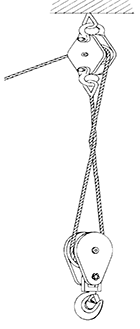When loaded, every wire rope will develop torque; that is it has the tendency:
? to unlay itself unless both rope ends are secured against rotation
? to cause a lower sheave block to rotate and to spin the line parts
together (see picture A)
 Picture A
Picture A
Rotation resistant ropes can be divided into 3 categories:
 Class I Non-Rotating, 3 layer (14 or more outer strands) e.g. 35WXK7 |
 Class II Rotation Resistant, 2 layer (11 to 13 outer strands) e.g. comapcted 18xk7 |
 Class III Spin-Resistant, 2 layer (8 to 10 outer strands) e.g. 8XK26WS-IWRC |
The characteristic of these wire ropes are that the outer layer is twisted in the opposite direction of their inner layers. The sometimes confusing issue is that many 8-, 9- and 10 strand constructions are 2-layer types but their inner strands are NOT twisted in the opposite direction and therefore these rope are NOT spin-resistant; plus, for the untrained eye these ropes look very much alike their spin-resistant variants. These and regular 6-strand ropes will spin violently and unlay themselves when loaded when one rope end is allowed to spin freely. They may also develop a significant drop in breaking strength and an even larger drop in their fatigue life characteristic (Torsion Fatigue).
To achieve any degree of resisting the tendency of a rope to spin and unlay under load all such rope types (other than 4-strand ones) are constructed with 2 or more layers of opposite twisted strands (see picture on right).
2-layer ropes (MULTI, compacted 18xk7) have a larger tendency to rotate than 3-layer ones (e.g. Class 34 x 7, compacted 35WXK7). Furthermore, 2-layer spin-resistant and rotation resistant ropes will develop only about 55% to 75% of their breaking strength when one end is allowed to rotate freely. This number increases to between 95% to 100% for 3-layer (e.g. 35WXK7 compacted) non-rotating ropes.
Another important issue is that 2-layer rotation resistant and 2-layer spin-resistant rope types have shown to break up from the inside. The 8 (e.g. 8×25 spin-resistant) or 12 outer strands (19×7, 19×19, 18XK7) are not able to evenly distribute the radial forces and because of the inherent internal strand cross overs (which make the rope spin- or rotation resistant) the resultant severe notching stresses cause the rope core to break up premature (unless the core is plastic coated). Unexpected and sudden rope failures may be the result. Moreover, 2-layer spin-resistant or rotation resistant ropes satisfy only low to moderate rotational resistance demands.
3-layer rope constructions (e.g. compacted 35WXK7) have many more outer strands which can much better distribute the radial pressures onto the reverse lay inner strands. These ropes should be selected for larger mobile- and ALL tower cranes.
Example of a 2-layer rotation resistant construction with 12 outer strands. (COMPAC 18)
Aulone provide wire ropes to suit the requirements of your applications, including non-rotating wire ropes and special wire ropes.
Non-rotating (non-rotational) wire ropes are used in various on and offshore cranes, various machinery, winches and trolleys, in the maritime and fisheries sector, on and offshore oil exploitation, civil and industrial construction, engineering and infrastructure works, underground and surface mining, timber mining and numerous other industries and applications.
Contact: AULONE
Phone: 86-15573139663
Tel: 86-0731-83165008
Email: [email protected]
Add: Address:Kaiyuan road 36,Chunkou,Liuyang, Hunan,China.